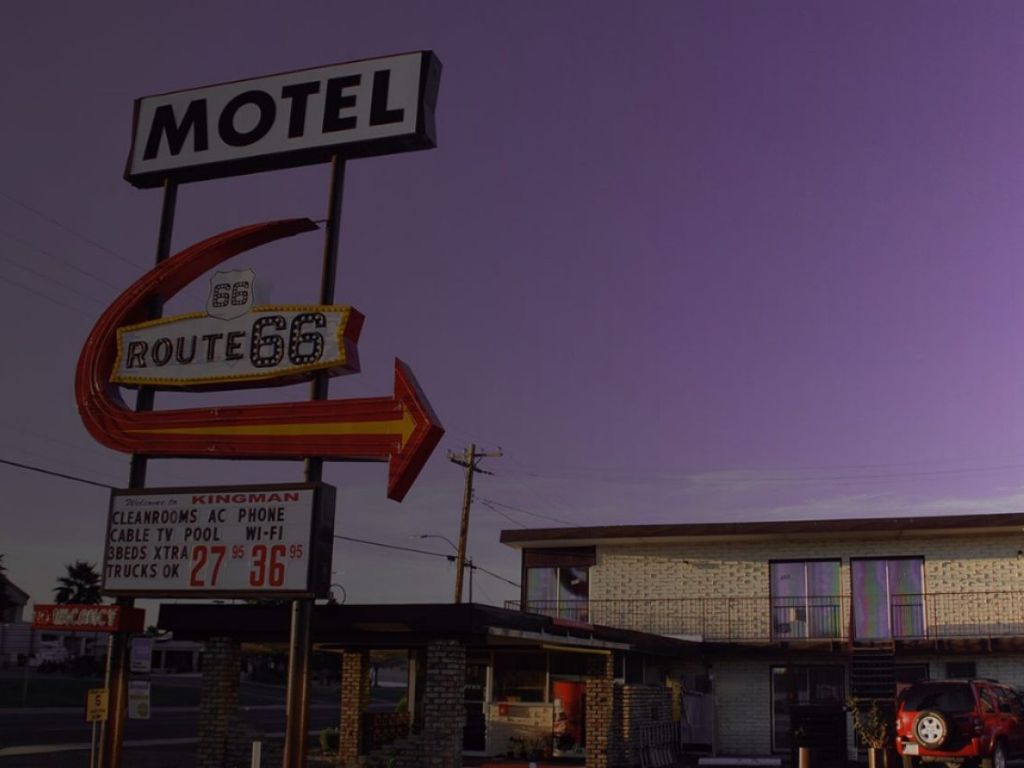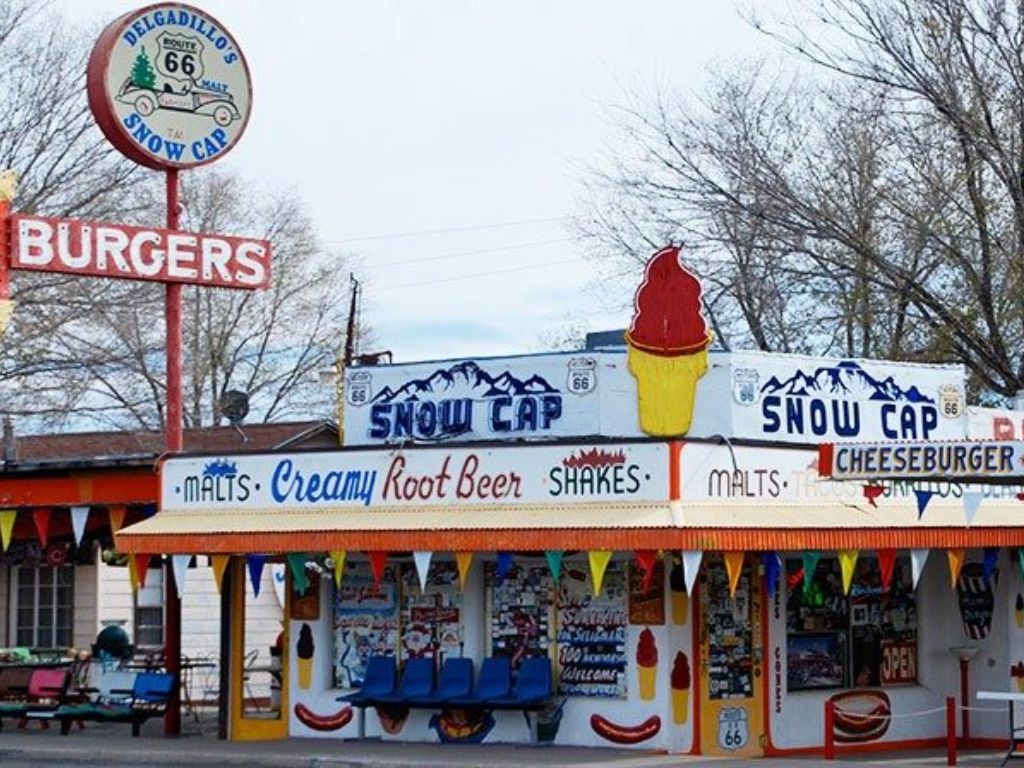It’s a world-class destination in its own right, but Las Vegas is also a great base for exploring the American Southwest. This mini road trip takes you east to the town of Flagstaff, Arizona – about a four and a half hour drive – with some surprising discoveries along the way.

The first section of your journey covers wilderness and desert, then you’ll drive along one of the best-known remaining stretches of old Route 66, past ramshackle diners and abandoned gas stations. Eventually, the Mother Road re-joins the main highway, towards the small town of Williams (jumping off point for the Grand Canyon train) and onwards to Flagstaff. So let’s leave Sin City behind…
Kingman, Arizona
Head southeast out of Las Vegas on Interstate 93, in the direction of Boulder City. Within half an hour you’ll reach the Nevada-Arizona state line at the Colorado River which means only one thing: the Hoover Dam and the first jaw-dropping moment of the journey. This awesome feat of engineering is definitely worth a longer trip, so find out more about visiting the Hoover Dam in our side trips to Las Vegas feature. But for now we’re continuing on…
You’re now in Arizona and an hour’s drive from Kingman, the first proper stop on our route. Follow US 93 south as it cuts through the heart of the Mount Wilson Wilderness Area, and note how barren the landscape becomes just 30 odd minutes from Las Vegas.
Kingman touts itself as the ‘Heart of Historic Route 66’, though in truth it’s much more of a pit stop than a must-see destination. During the mid-20th century, Route 66 led millions to the land of opportunity in California, and the town was a thriving and important stop on the journey. But now most visitors pass through en route to somewhere else.
That said, it’s really the only town of note between Las Vegas and the Grand Canyon and makes a decent stopover if part of a longer journey.
Kingman is the starting point for two popular excursions. Heading southwest, you’ll find yourself on one of the most desolates stretches of old Route 66. Multiple hairpin bends eventually lead to the old Wild West town of Oatman, where wild burros roam freely and mock shootouts entertain tourists.
Heading south from Kingman, the highway leads to Lake Havasu City, famous for a bizarre quirk: in the mid-1960s, the city’s founder purchased the old London Bridge from the British Government and reconstructed it here. Unbelievably, it’s now Arizona’s second biggest tourist attraction after the Grand Canyon. But our journey takes us east, along one of the longest continuous sections of Route 66 still in existence, looping north over Interstate 40 until the town of Ash Fork.
Old Route 66
Stretching from Chicago to Los Angeles, the creation of the 2,448-mile ‘Mother Road’ in 1926 linked together small towns across eight states, providing a new route to the promised land in search of a better life. Almost 90 years later, the road has long been replaced by the Interstate Highway System, but the remaining sections continue to inspire writers, photographers and lovers of a long-lost America.
Continue driving along Route 66 for 40 minutes and you’ll reach an unexpected sight. Out here in the middle of nowhere, an amazing non-profit organisation, Keepers of the Wild, is doing remarkable work looking after animals rescued from dire situations in the exotic pets and entertainment trades, providing a sanctuary for lions, tigers, wolves, monkeys and other animals to live out their natural lives in peace.
It’s worth taking a tour with one of the committed staff members to appreciate the dedication required to keep a place like this going. You’ll have your eyes truly opened to the scale of the problem that causes animals to come here in the first place, but although the stories are sad, the outcome is incredibly uplifting. If you’re an animal lover to any degree, this should be a must-stop on your itinerary.

Seligman
Other than the Grand Canyon Caverns, there’s not much else between here and the tiny town of Seligman, population 500. The lonely road continues through the rugged and remote Hualapai Indian Reservation for another fifty miles, so the sudden clutch of primary-coloured storefronts comes as something of a shock.
Seligman’s main street looks and feels like it was preserved in aspic about sixty years ago, when through traffic was its main source of economic security. Today, this is Arizona’s holy grail of Route 66 paraphernalia; a place to stock up on bumper stickers and key-rings, or snap photos of dusty parked-up Cadillacs.
On the one hand you could say Seligman shamelessly trades on its long-past glory days, but on the other – what choice did it have? Led by its best-known resident, Angel Delgadillo – known as the ‘guardian angel of Route 66’ – the town has worked hard to maintain the heritage of the road. And it has successfully stopped itself from turning into another Route 66 ghost town in the process.
Nowadays, the vast majority of visitors are curious road-trippers and tour buses, and these somehow manage to keep Seligman afloat. Do your part and head straight to the eccentric Delgadillo’s Snow Cap Drive-In for a root beer or burger – a fixture on the road since 1953 – and don’t miss the collection of vintage Chevrolets out the back. Or pop into the Route 66 Gift Shop next door and pay a visit to Angel himself. He certainly has some stories to tell.
Williams
Shortly after Seligman, Route 66 merges with Interstate 40. Head east towards Flagstaff and after forty minutes take exit 161 for the mountainside town of Williams, hunched at the base of Bill Williams Mountain and surrounded by forests of Ponderosa pine.
Another well-preserved section of Route 66 runs through the centre of town here – in fact, Williams was the final Route 66 community to be by-passed by the new interstate in 1984 – but the town is perhaps best known as the home of the Grand Canyon Railway, with daily trips to the canyon’s South Rim.
Williams has an atmospheric little downtown core that plays up both its railroad and Route 66 past. Lined with neon-lit diners, red brick hotels, galleries, coffee shops and the odd classic automobile, there’s still something of a frontier town vibe about the place – but it also feels thriving and current. There’s a decent outdoor sports scene here too – mountain biking, hiking, fishing, even skiing – which helps to attract visitors year round.
Flagstaff
After the relative remoteness of the journey so far, the college town of Flagstaff feels positively cosmopolitan. It’s the obvious base if you have plans to explore Northern Arizona in more depth. The historic grid-like downtown is full of interesting shops, hotels, restaurants, bars, and some fantastic murals and street art, all of which fosters a lively community feel.
Check out the old brick buildings along North Leroux, Birch and Aspen Streets for galleries full of Native American arts, crafts, jewellery and pottery. Then relax in the bar of the landmark Monte Vista Hotel and soak up the spirit of all the Hollywood stars who’ve stayed here over the past seventy years. Well over 100 movies were filmed in this part of Arizona during the 40s and 50s, and the hotel has hosted numerous big names including Humphrey Bogart, Clarke Gable, John Wayne and Jane Russell.
But for many, the town’s biggest draw is its location. Sheltered beneath the San Francisco peaks to the north is the Arizona Snowbowl ski and snowboarding resort, a mountain playground which doubles as a hiker’s paradise in summer. Flagstaff is also close to no less than three National Monuments: the ancient Sinagua cliff dwellings of Walnut Canyon; the multiple cinder cones of Sunset Crater Volcano, and the rambling three-storey Wupatki Pueblo.
Beyond Flagstaff
It’s the end of your journey – so what next? If the open road has you firmly under its spell, then we recommend continuing to the Route 66 town of Holbrook, gateway to Petrified Forest National Park and the Painted Desert.
Alternatively, if you’re heading back to Vegas and don’t want to retrace your tire tracks, Flagstaff serves as the obvious junction for circling back via the Grand Canyon, Lake Powell and Southern Utah.
by Maxine Sheppard
Image credits:
© Maxine Sheppard

.png.transform/375x812/image.png)

